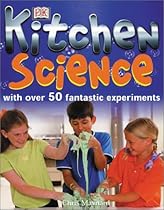Kitchen Science

| Author | : | |
| Rating | : | 4.46 (971 Votes) |
| Asin | : | 0789469723 |
| Format Type | : | paperback |
| Number of Pages | : | 48 Pages |
| Publish Date | : | 2017-02-03 |
| Language | : | English |
DESCRIPTION:
Rebecca of Amazon said 50 Fun Kitchen Experiments that teach!. I don't know about you, but cornstarch has always intrigued me. The way when you add water it gets so well, difficult to stir. So, why does it do this?Ahaso, cornstarch never really dissolves and that is why it forms tiny solid pieces suspended in the water. That is called a colloid. The harder you press them, the firmer they feel, but when you leave them alonethey drip. When mixing cornstarch in water, you will find this to be SO true. However, if you add enough water, you win. ;>So what fun will t. Great activities! Kirsten Gilbert Krenicky Quick and easy activities that have easy-to-find ingredients. BONUS! many of these activities dovetail nicely with the requirements for the Girl Scout Brownie Home Scientist badge.. Great book for science projects This was a great book with lots of ideas about easy science products made with every day home products. This book was very clear and easy to understand
Colored boxes explain exactly what is happening scientifically. Backyard Science treats insects and birds, soil science, water purification, sun and shadows, and more. Safety warnings are indicated in triangular icons. The superior design and clever texts, which use humor, instruction, and questioning to convey information, make these volumes new and fresh.Kathryn Kosiorek, Cuyahoga County Public Library, Brooklyn, OH Copyright 2001 Reed Business Information, Inc. Kitchen Science includes observations of mold growth, creating emulsions and colloids, bubble experiments, and fizzy projects using baking soda and vinegar. . From School Library Journal Grade 3-5-These titles are characterized by a spacious format; color photographs of attractive, enthusiastic children; and bright, clearly labeled procedures for basic experiments
Chris Maynard has written about 55 children's books. He won the Rhone-Poulenc Science Junior Book of the Year in 1996 (The World of Weather) and his Informania Sharks was runner up for the TES Senior Information Book Award in 1998. Recently, he has discovered the joys of writing websites too.
Science has come out of the laboratory and into the real world. Kids can become scientists in their own homes using everyday ingredients and supplies to carry out experiments.. Why do lemons give you a buzz? Why does a cornstarch and water mixture behave so strangely? What happens when you put water under pressure and why does it suffer from surface tension? Over 50 experiments show you that science is bubbling away all around us
